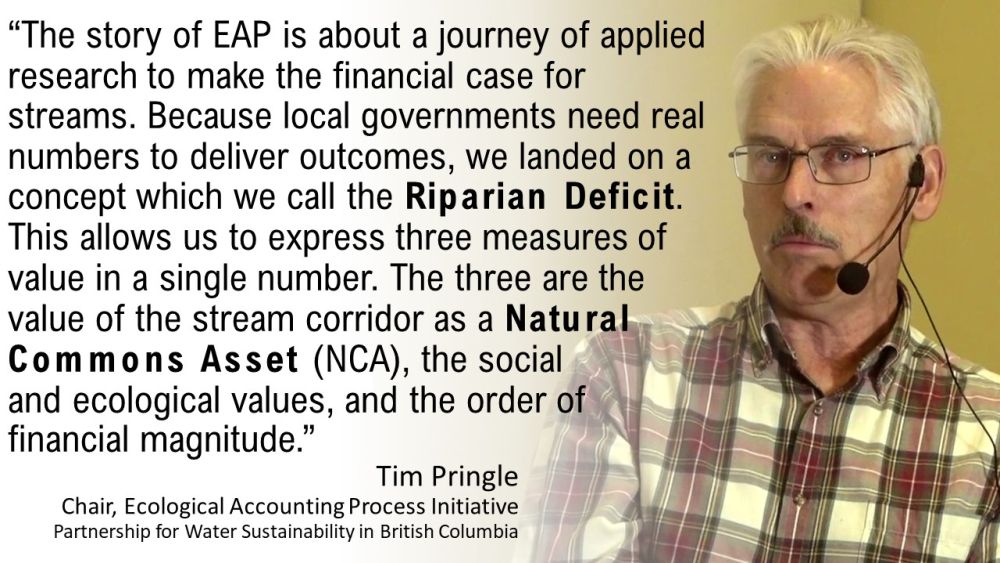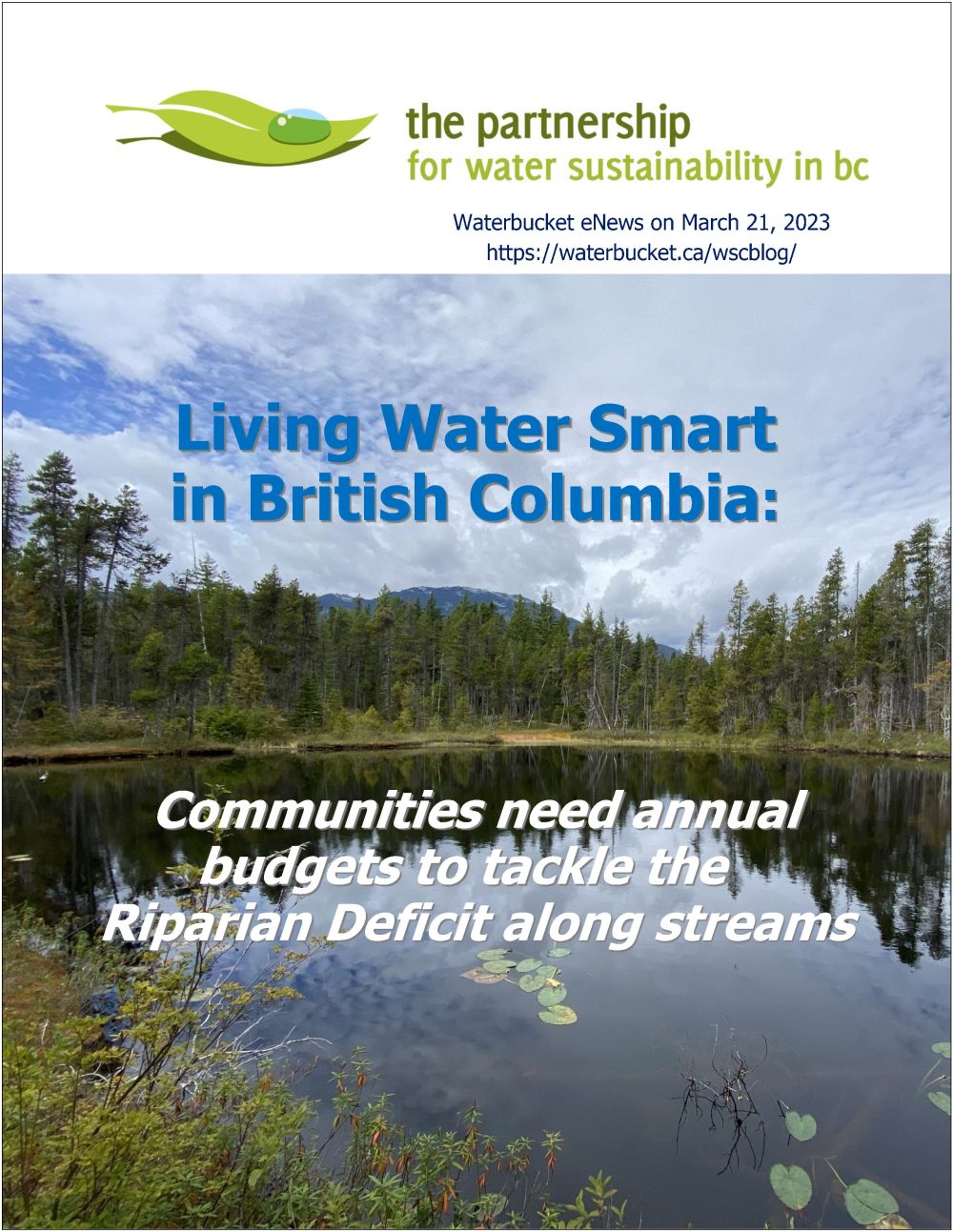CHALLENGES OF USING A PROFESSIONAL RELIANCE MODEL FOR ENVIRONMENTAL PROTECTION: “The requirement that local governments have an Asset Management Plan addresses the disconnect between land use oversight and direct responsibility for maintenance and management of stream corridor condition,” stated Tim Pringle, Chair of the Ecological Accounting Process (EAP) program
Note to Reader:
Waterbucket eNews celebrates the leadership of individuals and organizations who are guided by the Living Water Smart vision. The edition published on March 21, 2023 featured the story behind the story of the Nested Concepts graphic. The Partnership for Water Sustainability created it to help local governments move past rhetoric, address the disconnect between oversight of land use and responsibility for stream condition, and establish annual budgets for stream and riparian area restoration.
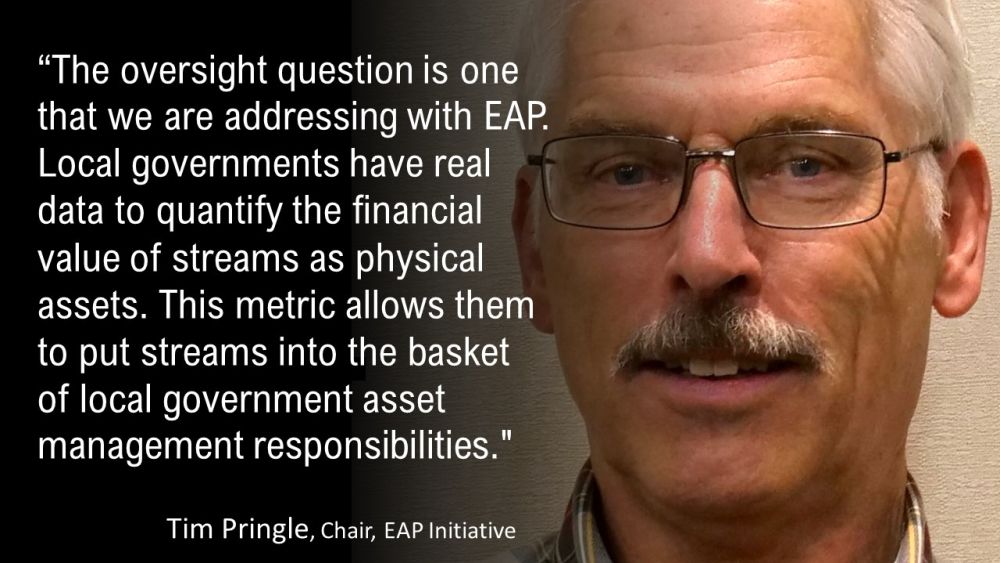
The requirement that local governments have an Asset Management Plan addresses the disconnect between land use oversight and direct responsibility for maintenance and management of stream corridor condition
If we know how to do a much better job of protecting ecological features and stream systems in our communities and on our landscape, then why aren’t we doing a better job? Why are streams still being degraded?
Why do we still see policies and practices that compromise the integrity of stream corridor systems and impose a downstream financial liability upon communities? How do we change that?
These and other questions have driven development of the methodology and metrics for EAP, the Ecological Accounting Process. The methodology and metrics focus on the land underlying the natural asset. In the case of stream systems, this is the setback zone defined in B.C. provincial legislation – namely, the Riparian Areas Protection Regulation.
Challenges of using a professional reliance model in environmental protection
The 2014 investigation and Striking a Balance report by the BC Ombudsperson identified “significant gaps between the process the provincial government had established when the Riparian Areas Protection Regulation was enacted and the level of oversight that was actually in place.”
Investigative Update: Striking a Balance (2022) states that “many of the issues we identified remain as pressing as they were in 2014; there is work ahead to ensure that the systemic issues are fully addressed.”
How do we change what we are doing on and to the landscape?
In 2019, UBCM and the Ministry of Municipal Affairs formalized an expectation that local governments applying for provincial grants would integrate “natural assets” into their asset management processes. EAP shows them how to do it for stream systems and wetlands.
EAP provides local governments with the real numbers they need to deliver outcomes. In addition, effective communication tools are essential to convey core concepts in a way that is easy for audiences to absorb.
Eliminating the disconnect between oversight of land use and responsibility for stream condition comes down to this question: What is the number for the line item in a local government annual budget for community investment in maintenance and management (M&M) of stream systems?
The Partnership for Water Sustainability created the Nested Concepts graphic (below) to help local governments move past rhetoric and address the disconnect. The spotlight is on funding actions that achieve restoration of streamside protection zones.
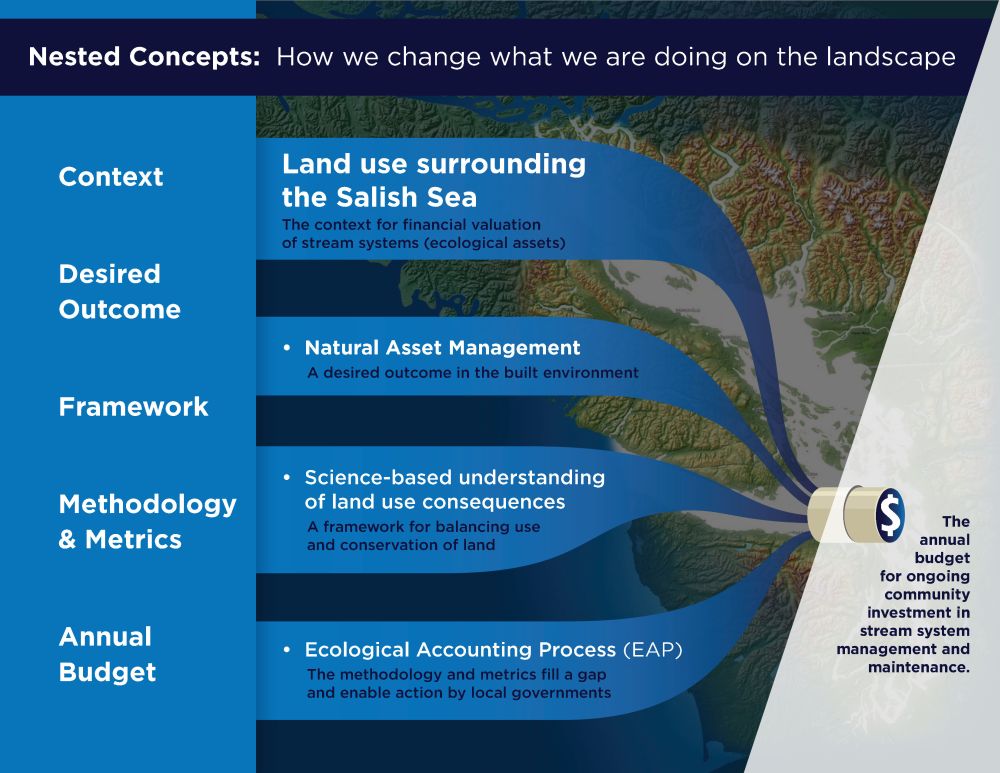
EDITOR’S PERSPECTIVE / CONTEXT FOR BUSY READER: Communities need annual budgets to tackle the Riparian Deficit along streams
“Partnership for Water Sustainability experience is that effective knowledge sharing is facilitated by communication tools that make it easy for audiences to grasp and absorb foundational concepts,” stated Kim Stephens, Waterbucket eNews Editor and Partnership Executive Director.
“At the conclusion of the 6-year program of applied research to evolve the methodology and metrics for EAP, the Ecological Accounting Process, Tim Pringle and I identified the need for a clear and compelling graphic that would encapsulate the essence of EAP.”
Consequences of weak oversight are measurable: As the EAP methodology and metrics evolved, we landed on the concept of the Riparian Deficit. In the local government context, the Riparian Deficit shows the magnitude, a measurable consequence, of the disconnect between land use oversight and direct responsibility for maintenance and management (M&M) of stream corridor conditions.
“In the report series, Striking a Balance, the BC Ombudsperson identified failure by local government to employ adequate oversight of stream systems. Historical land use decisions often have resulted in stream systems being ‘leftovers’ in development that alters watersheds and stream corridors.”
“The Riparian Deficit shows the magnitude or measurable consequence of weak oversight and failure to manage stream corridors and adjacent riparian areas.”
How we change what we are doing on the landscape:
“It required a process for us to develop the Nested Concepts graphic. How will the graphic be used, we asked ourselves? How do we communicate with a range of audiences, from academics to political folks, about core concepts?”
“When the smoke cleared, we had distilled the essence of EAP into a set of succinct statements that we believe paint a picture and thus tell a story. In a very real sense, it is a case of less being more. We knew we had to keep it simple. Once we had the words right, a graphics designer brought our words to life in a visual way.”
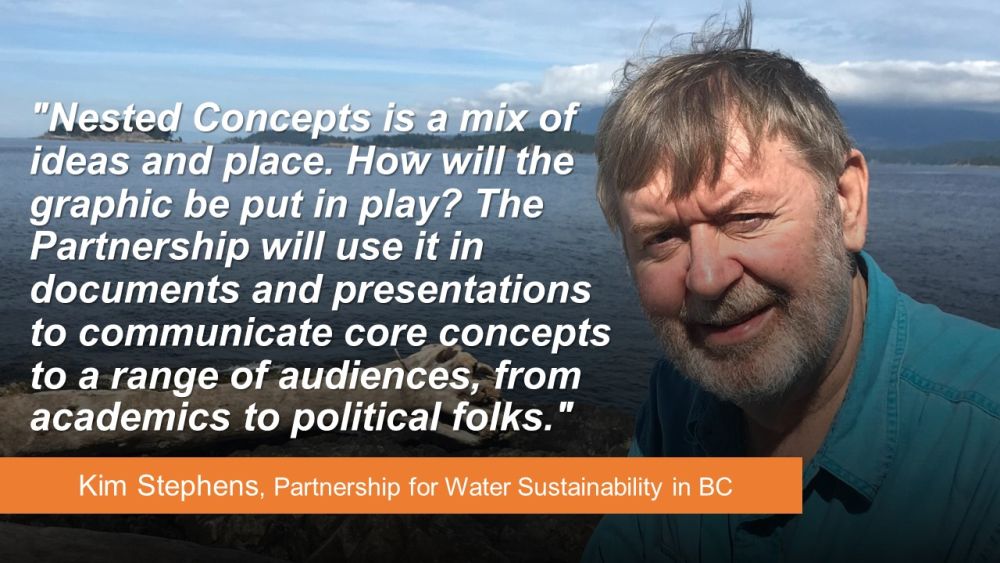
STORY BEHIND THE STORY: Nested Concepts graphic illustrates how we change what we are doing on the landscape
The essence of the challenge as Tim Pringle and I saw it was figuring out how we would communicate a mix of ideas and place, with ‘the place’ being the Salish Sea and the lands surrounding and draining into it.
In broad terms, this place in the southwest corner of British Columbia is called the Georgia Basin Bioregion. But it is more than just British Columbia because the bio-region includes the tributary land that is situated in the northwest corner of Washington State.
The Salish Sea itself is made up of two bodies of water – Puget Sound in Washington State and the Strait of Georgia in British Columbia. We call it the Salish Sea. But it is more like a big lake. In fact, and in terms of size, the Salish Sea has dimensions comparable to Lake Champlain in the state of Vermont in the eastern United States.

Could Today’s Problems be Tomorrow’s Opportunities?
We concluded that the Nested Concepts graphic need not explain things in great detail. It just had to engage the attention of the reader who then would want to learn more.
So, we asked ourselves, how do we frame what the issue is and what communities need to do? Well, the issue is that the way we develop land has adverse consequences for the health of the streams and rivers flowing into the Salish Sea. And those consequences impose a financial liability upon communities.
The flip side of a problem is an opportunity. So, what must communities do to turn today’s problems into tomorrow’s opportunities? The answer is to begin the process of changing what we are doing on the landscape, one property at a time, to move from cumulative impacts to cumulative benefits.
Simply put, that means change our development practices by designing with nature. This means respecting natural systems. This is not a new idea. The legendary Ian McHarg introduced it in the 1960s. This way of thinking has been embedded in our convening for action language in British Columbia for the past two decades. The Partnership develops tools and resources to support and enable designing with nature.
With these thoughts as the backdrop, the structure for the Nested Concepts graphic nicely fell into place.

Five Nested Concepts tell a story
CONTEXT – Land use surrounding the Salish Sea
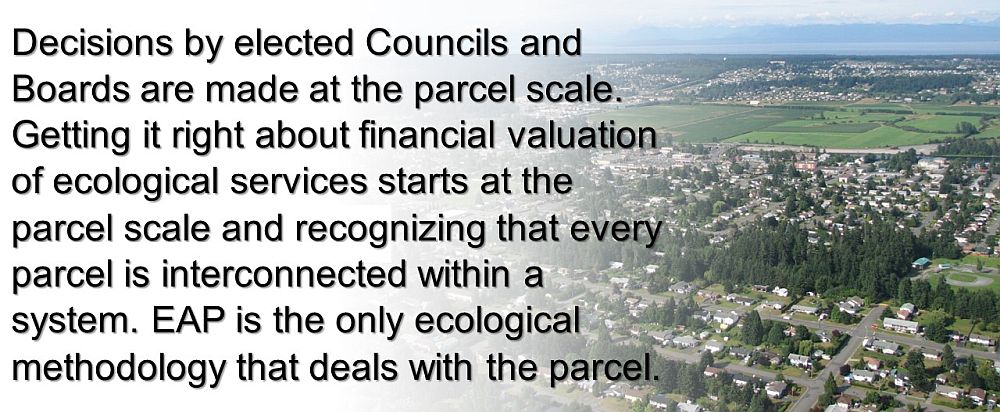
DESIRED OUTCOME – natural asset management in the built environment
We manage what we measure. We can manage engineering infrastructure because we have hard numbers. We know, for example, what it costs to supply and install buried pipe. Yet we have an Infrastructure Deficit because historically communities have not done a good job in planning ahead for renewal or replacement.
But that ‘failure to manage’ is now being remedied through implementation of Asset Management for Sustainable Service Delivery: A BC Framework.
Success in moving forward with Engineered Asset Management gives us confidence that we can do the same for Natural Asset Management. But success will only follow if we get three elements right. In order of priority, the three are: guiding philosophy, pragmatic methodology, and defensible metrics.
The Partnership for Water Sustainability describes the progression as a journey along the Asset Management Continuum. The local government reality is that it is one step at a time and incremental progress takes time.

FRAMEWORK – science-based understanding of land use consequences
Rich Horner and Chris May are the Washington State researchers who correlated changes on the landscape with the consequences for streams. In the mid-1990s, their findings were transformational. Their work shook the foundations of traditional engineering practice. Horner and May provided us with a science-based framework for balancing use and conservation of land.
The Partnership calls this the Roadmap for Protecting Stream System Integrity. We must stay true to the science if we hope to make a difference. The problem is the gap or disconnect between what communities know should be done versus what they allow to continue. That is an ever-present challenge.
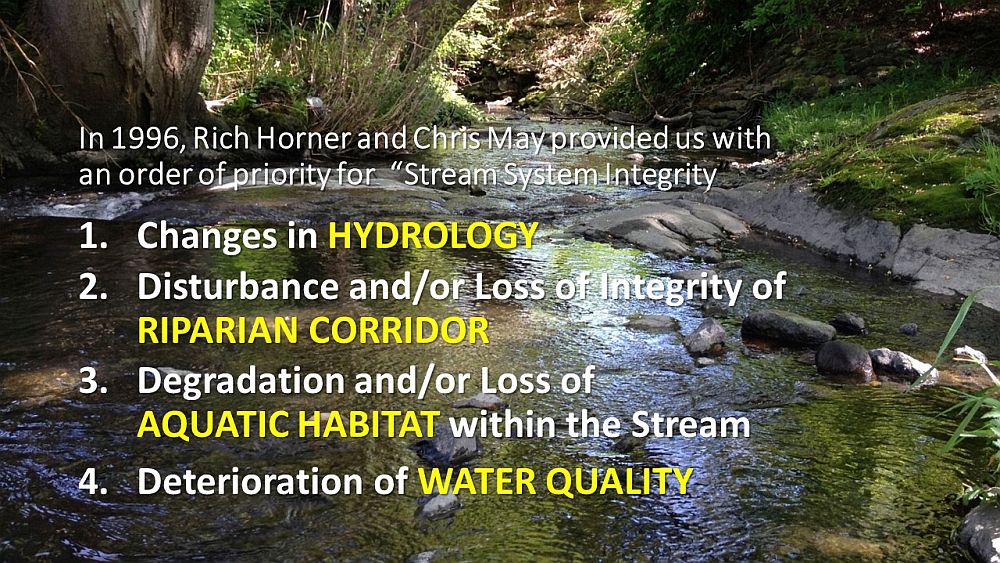
METHODOLOGY & METRICS – Ecological Accounting Process (EAP)
Streams in urban, suburban and rural settings are assets that require maintenance and management (M&M). EAP provides an original way to analyze and present data from existing sources as well as field observations. The EAP methodology and metrics fill the gap and would thus enable action by local government.
The Riparian Deficit is a measure of land use intrusion along streams. A comparatively low value is a positive indicator of the effectiveness of streamside setback regulation. The Riparian Deficit is equivalent to the well-known Infrastructure Deficit that currently drives Asset Management for Sustainable Service Delivery.
Having a number for the Riparian Deficit provides environmental planners with a point of departure for balanced inter-departmental conversations about the services that natural and constructed assets each provides.

ANNUAL BUDGET – how much
There are two basic questions that drive Asset Management for Sustainable Service Delivery. One, what does maintenance and management (M&M) of stream systems cost? Two, where does the money come from?
With EAP, local governments have the tool they need to populate line items within Asset Management Budgets for ongoing investment in stream system M&M, just as they would do for an engineered asset.
Realistic, affordable and acceptable – those three attributes describe a defensible budget.
